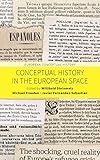Conceptual History in the European Space / ed. by Michael Freeden, Willibald Steinmetz, Javier Fernández-Sebastián.
Material type: TextSeries: European Conceptual History ; 1Publisher: New York ; Oxford : Berghahn Books, [2017]Copyright date: ©2017Description: 1 online resource (320 p.)Content type:
TextSeries: European Conceptual History ; 1Publisher: New York ; Oxford : Berghahn Books, [2017]Copyright date: ©2017Description: 1 online resource (320 p.)Content type: - 9781785334825
- 9781785334832
- Concepts -- History
- Europe -- History -- Periodization
- Semantics, Historical
- Space and time -- Political aspects -- Europe -- History
- Space and time -- Social aspects -- Europe -- History
- HISTORY / Historiography
- center periphery dynamics
- contemporary insights and debates
- europe
- european history
- european project
- historical
- historiography of concepts
- historiography
- indispensable contextualization
- overviews of contested theoretical terrain
- spatiality
- translatability
- 940.01 23
- D16.8 .C625 2017
- online - DeGruyter
| Item type | Current library | Call number | URL | Status | Notes | Barcode | |
|---|---|---|---|---|---|---|---|
 eBook
eBook
|
Biblioteca "Angelicum" Pont. Univ. S.Tommaso d'Aquino Nuvola online | online - DeGruyter (Browse shelf(Opens below)) | Online access | Not for loan (Accesso limitato) | Accesso per gli utenti autorizzati / Access for authorized users | (dgr)9781785334832 |
Frontmatter -- Contents -- Figures -- Introduction. Conceptual History: Challenges, Conundrums, Complexities -- Chapter 1 Europe at Different Speeds: Asynchronicities and Multiple Times in European Conceptual History -- Chapter 2 Multiple Transformations: Temporal Frameworks for a European Conceptual History -- Chapter 3 Concepts and Debates: Rhetorical Perspectives on Conceptual Change -- Chapter 4 Conceptual History, Ideology and Language -- Chapter 5 Transnational Conceptual History, Methodological Nationalism and Europe -- Chapter 6 Conceptual History: The Comparative Dimension -- Chapter 7 Concepts, Contests and Contexts: Conceptual History and the Problem of Translatability -- Chapter 8 Conceptualizing Spaces within Europe: The Case of Meso-Regions -- Chapter 9 Conceptualizing Modernity in Multiand Intercultural Spaces: The Case of Central and Eastern Europe -- Chapter 10 Concepts in a Nordic Periphery -- Conclusions: Setting the Agenda for a European Conceptual History -- Index
restricted access online access with authorization star
http://purl.org/coar/access_right/c_16ec
The result of extensive collaboration among leading scholars from across Europe, Conceptual History in the European Space represents a landmark intervention in the historiography of concepts. It brings together ambitious thematic studies that combine the pioneering methods of historian Reinhart Koselleck with contemporary insights and debates, each one illuminating a key feature of the European conceptual landscape. With clarifying overviews of such contested theoretical terrain as translatability, spatiality, and center-periphery dynamics, it also provides indispensable contextualization for an era of widespread disenchantment with and misunderstanding of the European project.
Mode of access: Internet via World Wide Web.
In English.
Description based on online resource; title from PDF title page (publisher's Web site, viewed 25. Jun 2024)


